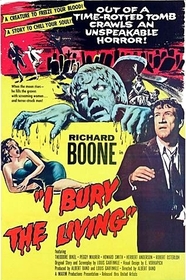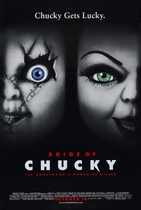Our editor-in-chief Nate Yapp is proud to have contributed to the new book Hidden Horror: A Celebration of 101 Underrated and Overlooked Fright Flicks, edited by Aaron Christensen. Another contributors include Anthony Timpone, B.J. Colangelo, Dave Alexander, Classic-Horror.com's own Robert C. Ring and John W. Bowen. Pick up a copy today from Amazon.com!
I Bury the Living (1958)
Well, the video cover art on the copy I purchased was certainly misleading, but I Bury the Living is a pretty good film -- kind of a cross between a "Twilight Zone" episode (while preceding that show by a year) and a mystery with hints of supernatural horror elements thrown in for good measure. Plus, it has historical/trivial interest to boot--it was produced and directed by Albert Band, father of the now more famous entrepreneur behind Full Moon video, Charles Band, and film composer Richard Band.
The video box, with wonderfully garish art suggesting a "mondo" or exploitation film, says things like, "When the moon rises--he fills the graves with screaming women . . . and terror-struck men!"; "A creature to freeze your blood!"; "A story to chill your soul!" and "Out of a time-rotted tomb crawls an unspeakable horror!"
As good as all that might sound, it has little to do with I Bury the Living. Instead, the story concerns Robert Kraft (Richard Boone, a veteran of Westerns), a businessman from a long line of businessmen, who, as chairman of the board for his corporation, has also been inducted to function in a supervisory role for a cemetery. The cemetery office contains two significant things. A groundskeeper of 40 some years who the board is "encouraging" to retire, and a huge map of the cemetery, complete with white pins for pre-purchased, but unoccupied plots and black pins for occupied or soon-to-be-occupied plots. On Kraft's first day at the cemetery, a young couple arrives and purchases plots. Kraft accidentally places black pins instead of white to mark their plots on the map, and a day later, the young couple is dead -- they were victims in an automobile crash.
He doesn't notice this until he returns the next day, and it immediately spooks him. On a whim, he places a black pin randomly in the map, and as you might guess, the person who the plot belonged to ends up dead--of natural causes.
Already, that would probably seem a bit too much of a further coincidence to justify continuing to experiment with black pins, but absurd as it is -- and this is one of the things that remarkably make I Bury the Living work as a quirky, enjoyable film -- Kraft makes no secret of the mysterious occurrences, going so far as completely filling in the police and a reporter friend, and everyone around him encourages him to keep trying the black pins, because "surely with such-and-such combination" it will be clear to you that these incidents are coincidence.
Band masterfully creates suspense out of this situation that could have easily turned into a comedy given that plot decision. A more stereotypical choice might have been to turn Kraft into a madman, abusing his newfound power. Band takes a more interesting road, creating a fine, atmospheric mystery/thriller, complete with a few, choice, subtle but impressive visual effects for 1958. Also notable visually is the cemetery map itself (and the pins) . . . that simple, but interestingly non-symmetrical image (especially the graceful and unusually curving road) has already been burned into my memory, and I suspect it will remain there for some time to come.
Still, in retrospect, I Bury the Living is a bit thin and seems more like a made for TV film than a major theatrical release. Marketed as horror -- at least presently -- it really has little to do with that genre in any more than a very superficial aspect --even though horror is hinted at.
Also, I Bury the Living is definitely a slower-paced, black and white film focusing mostly on dialogue. Any fans without a taste for that should stay away from I Bury the Living. But fans with a taste for films of the era, "Twilight Zone" fans, and even fans of noirish detective films, as well as those interested in seeing some of the work of Charles Band's father, should not hesitate in giving this film a chance.








